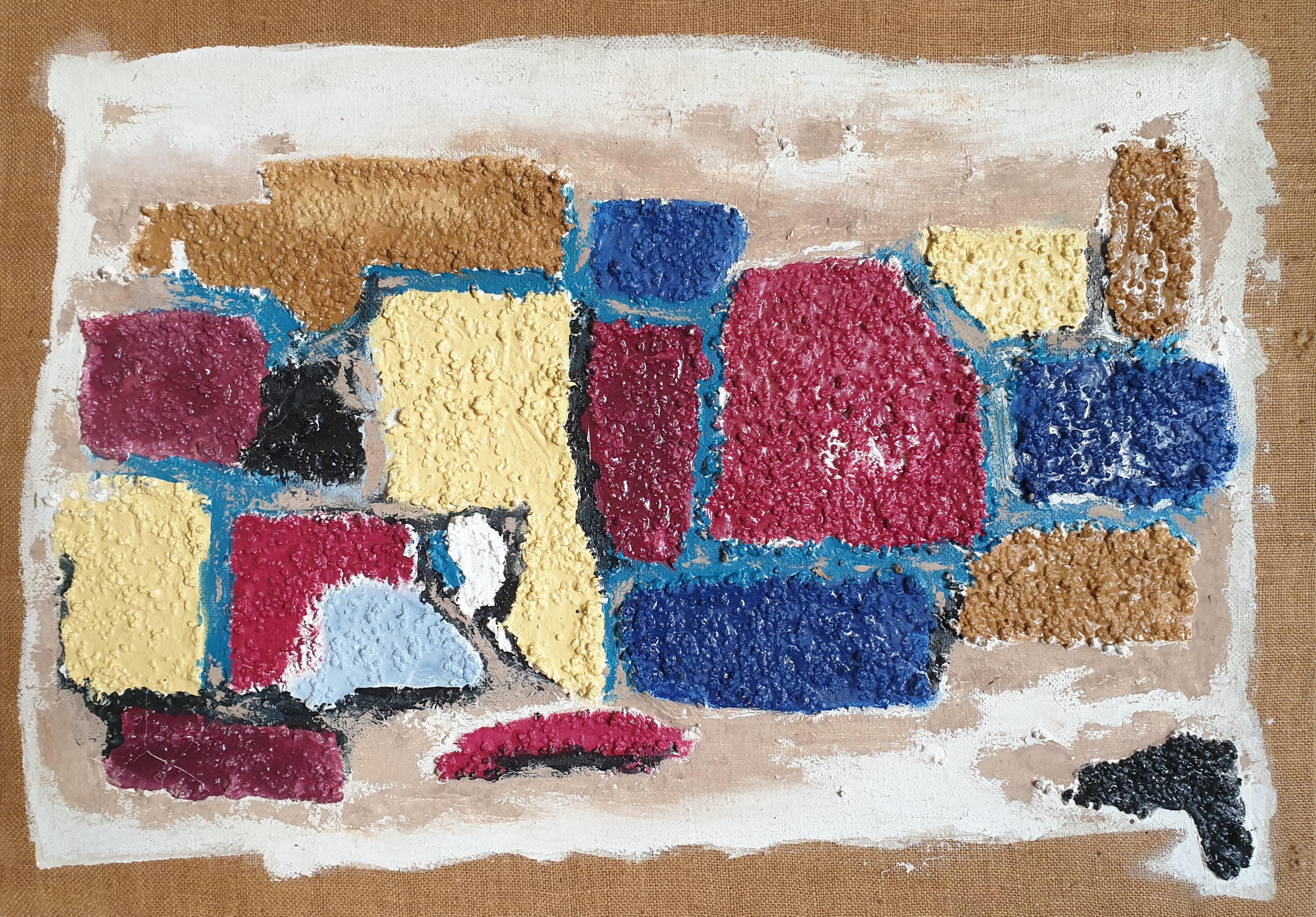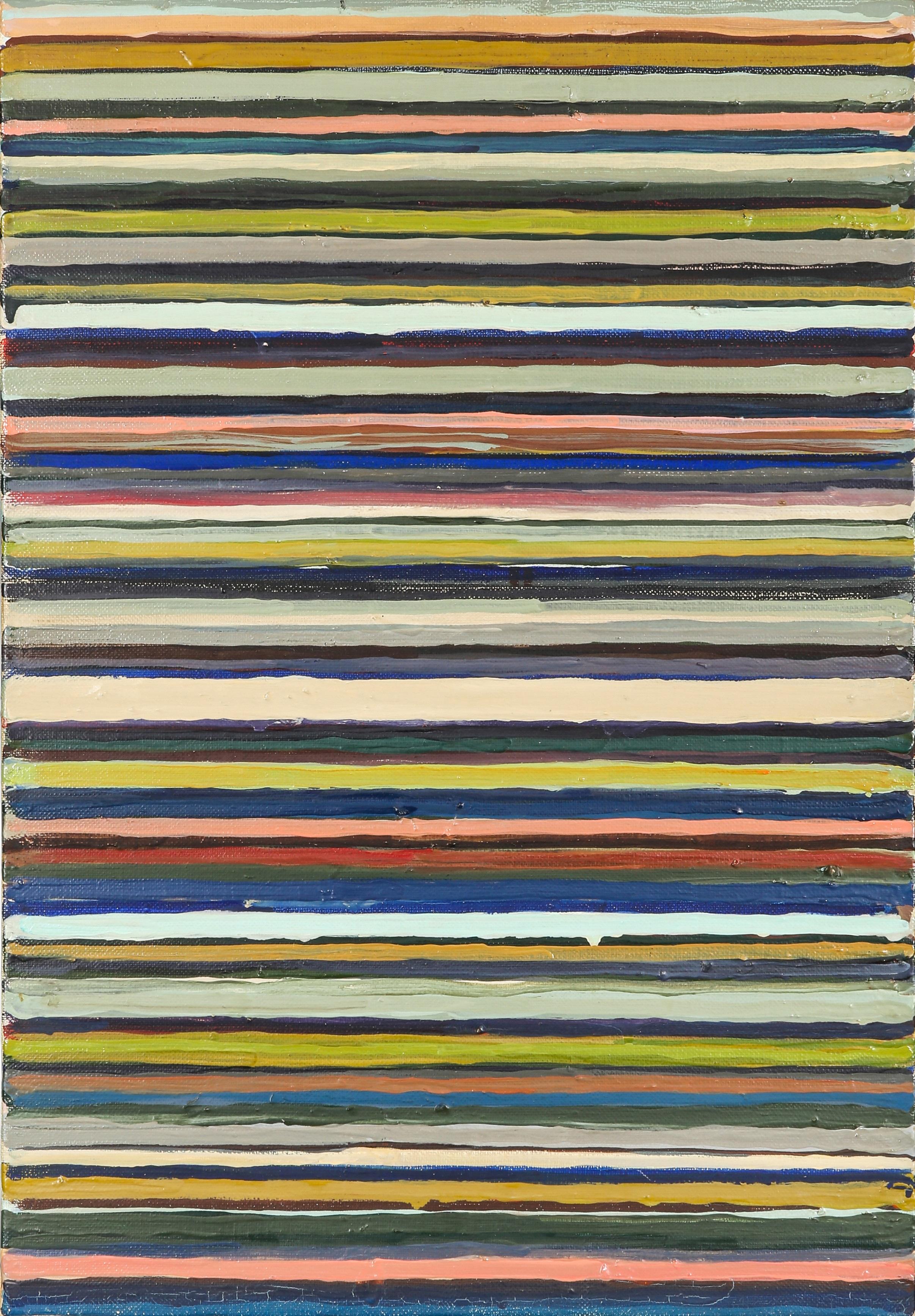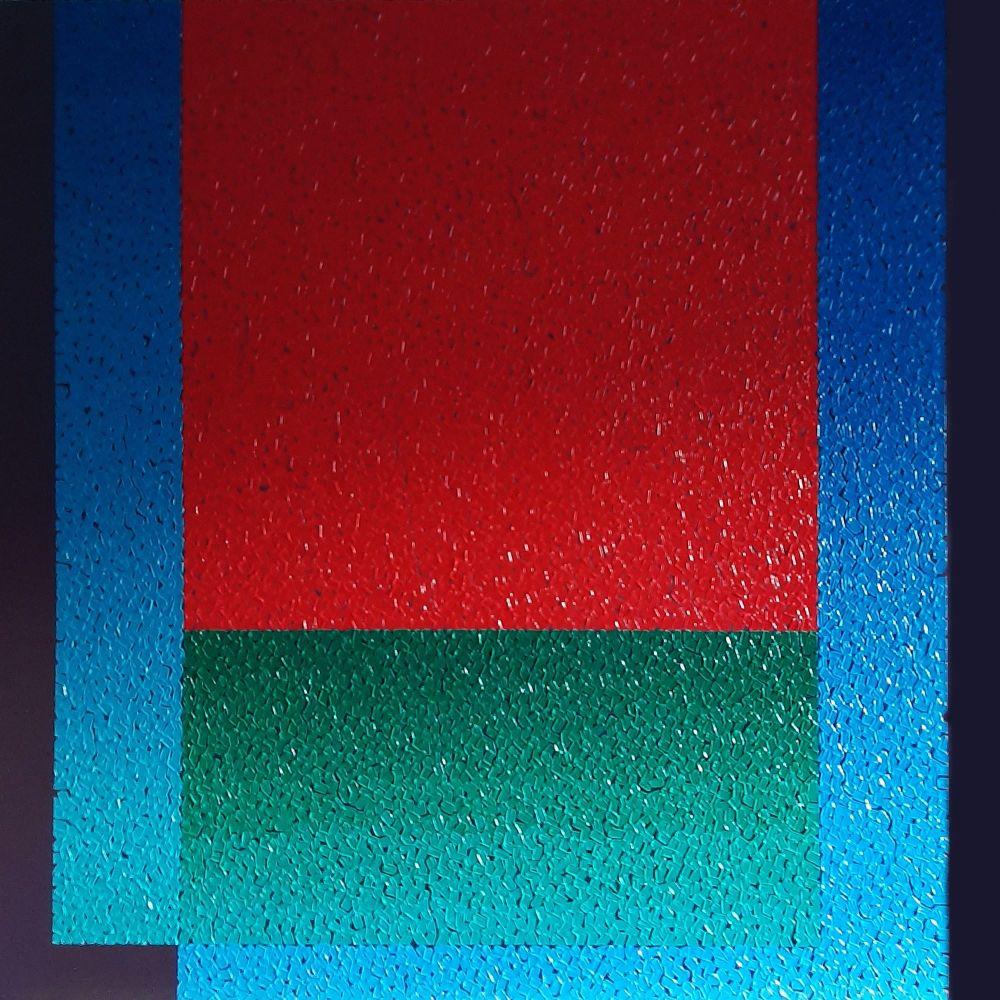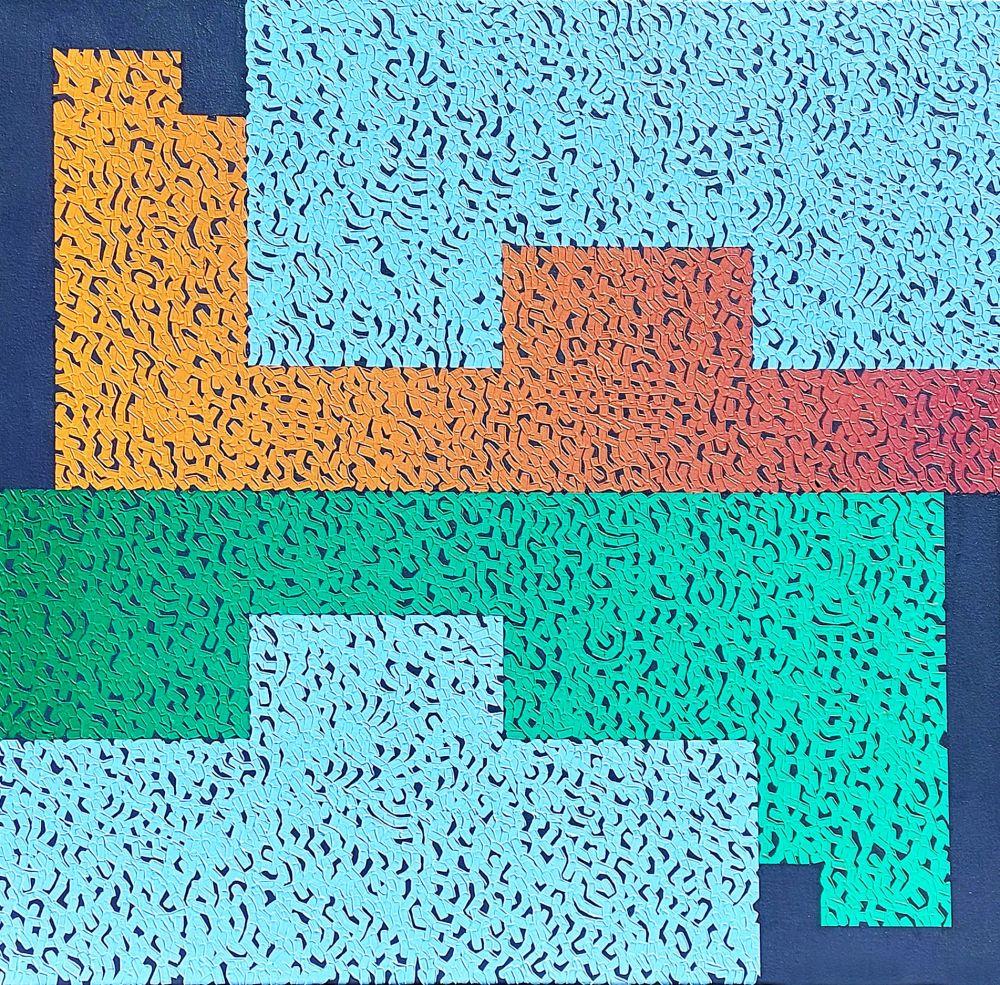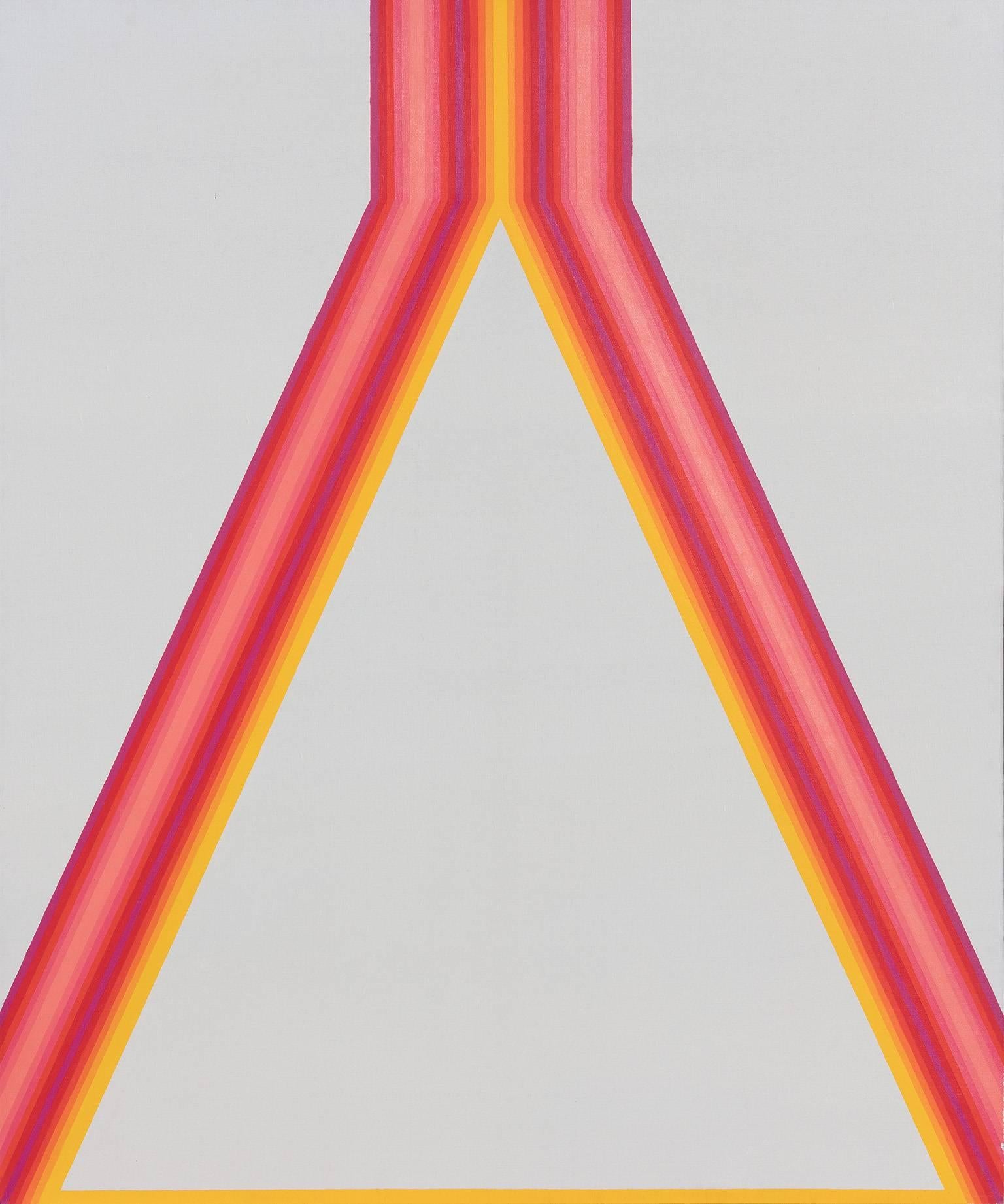David Adickes"Forms" Black, Green, Red, and Orange Abstract Geometric Painting1960
1960
About the Item
- Creator:David Adickes (1927, American)
- Creation Year:1960
- Dimensions:Height: 26.5 in (67.31 cm)Width: 34.38 in (87.33 cm)Depth: 1 in (2.54 cm)
- Medium:
- Movement & Style:
- Period:
- Condition:Wear consistent with age.
- Gallery Location:Houston, TX
- Reference Number:
David Adickes was born in Huntsville, Texas in 1927 and graduated from Huntsville High School in 1943. Nearing the end of World War II, at age 17, he joined the U.S. Air Force and regularly traveled to France. “I always liked art and was always drawing in the margins of my book,” Adickes said. “But being in Paris where there are galleries and museums on every corner — as just a small town kid from Huntsville, Texas — that was my turning point.” After completing his service, Adickes returned to Huntsville and earned his bachelor’s degree from Sam Houston State University. He then studied art with artist Fernand Leger in France for two years before moving to Houston to open his own art school.
(Biography provided by Reeves Antiques)
- ShippingRetrieving quote...Ships From: Houston, TX
- Return PolicyA return for this item may be initiated within 7 days of delivery.
- "VM 4" Green and Yellow Striped Abstract Contemporary PaintingLocated in Houston, TXContemporary abstract geometric painting by artist Mark Byckowski. The work is featured in a series of paintings. The work features horizontal lines with a variety of vivid colors of...Category
Early 2000s Abstract Geometric Abstract Paintings
MaterialsCanvas, Acrylic
- "VM 7" Red Orange-Toned Striped Geometric Abstract PaintingLocated in Houston, TXContemporary abstract geometric painting by artist Mark Byckowski. The work is featured in a series of paintings. The work features horizontal lines with a variety of vivid colors of...Category
21st Century and Contemporary Abstract Geometric Abstract Paintings
MaterialsCanvas, Acrylic
- "VM 3" Green and Yellow Striped Abstract Contemporary PaintingLocated in Houston, TXContemporary abstract geometric painting by artist Mark Byckowski. The work is featured in a series of paintings. The work features horizontal lines with a variety of vivid colors of red, blue, green, and yellow, painted on a black background. Each work in the series features a bright red line at the bottom right corner. Signed, titled, and dated on reverse. Currently unframed, but options are available. Artist Biography: Mark Byckowski was born March 18, 1957 in Chicago, Illinois. He remained in and out of the Chicago area until moving to Raleigh, North Carolina in 1990. In 2016 moved to Livingston, Texas where he currently resides. At an early age he began drawing, studying, and creating art which has continued throughout his life. His artwork has changed and evolved through different periods and styles that span for decades. In the early years he was influenced by traditional representational artists and illustrators, then impressionism, surrealism and the avant-garde of modernism captured his imagination. His artistic talent eventually led him to Northern Illinois University where he received Dean List Honors in Fine Art with an emphasis in studio painting. As a studio artist he has produced a body of work in a variety of media painting, drawing, sculpture, print making, and computer art also known as digital art. While in college the artist began searching for an original idea and style of his own. In 1979 when the first apple personal computers became available in the art department. He immediately knew the technology would eventually influence the direction of fine art in the future. It took time to learn how to program and explore the possibilities of computers as a new tool in the creation of art. Personal computers back then did not have the capabilities they have today and were not user-friendly. There were only two fine artists Mark Pinson and I working with computer technology back then. We worked on our own ideas and after completing the programs and turning them into paintings and drawings we collaborated and mounted a two-man exhibition. My first program was a series of interconnected images entitled “Concatenation” paintings and drawings created from the program were exhibited with Mark Pinson’s work entitled “Random” in a two- man show at The Holmes Center Gallery, Northern Illinois University on November 30, 1980. The second program entitled “Visual Music” the paintings and drawings exhibited in a one man show at The Recital Hall Music Building Gallery, Northern Illinois University on April 26, 1981. Followed by an exhibit sponsored by Illinois Bell, works on paper selected a drawing from the Visual Music series for “A New Generation of Artists” at The Lobby Gallery, 225 West Randolph Street, Chicago, Illinois, May 14 through June 12, 1981. The artist has participated in exhibitions dating back to 1974. The above exhibitions were selected because they marked a new beginning and direction in the artist’s work that continues to the present day. Other positions held in the Fine Art field include: 1984-1985- Austin Galleries, Michigan Avenue, Chicago, Illinois (Main Gallery) and other locations Fine Art Consultant / Gallery Director 1982-1984- Atlas Galleries, Michigan Avenue, Chicago, Illinois (Main Gallery) and other locations Fine Art Consultant / Assistant Gallery Director Artist Statement: Subject matter for computer art, painting, and drawing Mark S. Byckowski In 1979 searching for a for an original idea and style of my own I began looking for abstract ideas that I could program with a computer for a new a paintings series. I decided on an idea called “Concatenation” a series beginning from the original image undergoing a transformational change from the previous image connected in a linked series. Example: Image 1 is the original, image 2 changes image 1 by adding a new line, and image 3 changes image 2 by adding an additional new line. Continually changing the previous image by adding an additional line etc. In 1980 I began working on a new abstract idea that I could again program with a computer for a new painting and drawing series. The similarities between music and art intrigued me and began thinking about how I could create a visual representation of musical sound. In music notes are arrangements turned into compositions. In art color is also, arranged into compositions and both seek aesthetic rhythms and harmony. Depending on what notes or colors used can also, affect different emotions and moods. The Artists painting process Step one: Create the computer drawing. For years I have used Microsoft classic paint to create drawings. It allows me to arrange an aesthetic composition and select a color scheme in advance. I can make changes easily until I am satisfied. Step two: I build a custom stretcher frame with support bars and corner braces. Step three: Measure and Stretch the canvas onto the frame pulling the canvas and using a staple gun...Category
Early 2000s Abstract Geometric Abstract Paintings
MaterialsAcrylic, Canvas
- "VM 9" Red Striped Abstract Geometric PaintingLocated in Houston, TXContemporary abstract geometric painting by artist Mark Byckowski. The work is featured in a series of paintings. The work features horizontal lines with a variety of vivid colors of red, purple, green, and yellow, painted on a black background. Each work in the series features a bright red line at the bottom right corner. Signed, titled, and dated on reverse. Currently unframed, but options are available. Artist Biography: Mark Byckowski was born March 18, 1957 in Chicago, Illinois. He remained in and out of the Chicago area until moving to Raleigh, North Carolina in 1990. In 2016 moved to Livingston, Texas where he currently resides. At an early age, he began drawing, studying, and creating art which has continued throughout his life. His artwork has changed and evolved through different periods and styles that span for decades. In the early years, he was influenced by traditional representational artists and illustrators, then impressionism, surrealism, and the avant-garde of modernism captured his imagination. His artistic talent eventually led him to Northern Illinois University where he received Dean List Honors in Fine Art with an emphasis in studio painting. As a studio artist, he has produced a body of work in a variety of media painting, drawing, sculpture, print making, and computer art also known as digital art. While in college the artist began searching for an original idea and style of his own. In 1979 when the first apple personal computers became available in the art department. He immediately knew the technology would eventually influence the direction of fine art in the future. It took time to learn how to program and explore the possibilities of computers as a new tool in the creation of art. Personal computers back then did not have the capabilities they have today and were not user-friendly. There were only two fine artists Mark Pinson and I working with computer technology back then. We worked on our own ideas and after completing the programs and turning them into paintings and drawings we collaborated and mounted a two-man exhibition. My first program was a series of interconnected images entitled “Concatenation” paintings and drawings created from the program were exhibited with Mark Pinson’s work entitled “Random” in a two-man show at The Holmes Center Gallery, Northern Illinois University on November 30, 1980. The second program entitled “Visual Music” the paintings and drawings exhibited in a one man show at The Recital Hall Music Building Gallery, Northern Illinois University on April 26, 1981. Followed by an exhibit sponsored by Illinois Bell, works on paper selected a drawing from the Visual Music series for “A New Generation of Artists” at The Lobby Gallery, 225 West Randolph Street, Chicago, Illinois, May 14 through June 12, 1981. The artist has participated in exhibitions dating back to 1974. The above exhibitions were selected because they marked a new beginning and direction in the artist’s work that continues to the present day. Other positions held in the Fine Art field include: 1984-1985- Austin Galleries, Michigan Avenue, Chicago, Illinois (Main Gallery) and other locations Fine Art Consultant / Gallery Director 1982-1984- Atlas Galleries, Michigan Avenue, Chicago, Illinois (Main Gallery) and other locations Fine Art Consultant / Assistant Gallery Director Artist Statement: Subject matter for computer art, painting, and drawing Mark S. Byckowski In 1979 searching for a for an original idea and style of my own I began looking for abstract ideas that I could program with a computer for a new a paintings series. I decided on an idea called “Concatenation” a series beginning from the original image undergoing a transformational change from the previous image connected in a linked series. Example: Image 1 is the original, image 2 changes image 1 by adding a new line, and image 3 changes image 2 by adding an additional new line. Continually changing the previous image by adding an additional line etc. In 1980 I began working on a new abstract idea that I could again program with a computer for a new painting and drawing series. The similarities between music and art intrigued me and began thinking about how I could create a visual representation of musical sound. In music notes are arrangements turned into compositions. In art color is also, arranged into compositions and both seek aesthetic rhythms and harmony. Depending on what notes or colors used can also, affect different emotions and moods. The Artists painting process Step one: Create the computer drawing. For years I have used Microsoft classic paint to create drawings. It allows me to arrange an aesthetic composition and select a color scheme in advance. I can make changes easily until I am satisfied. Step two: I build a custom stretcher frame with support bars and corner braces. Step three: Measure and Stretch the canvas onto the frame pulling the canvas and using a staple gun...Category
21st Century and Contemporary Abstract Geometric Abstract Paintings
MaterialsAcrylic, Canvas
- "VMP 2" Green, Blue and Yellow Striped Abstract Contemporary PaintingLocated in Houston, TXContemporary abstract geometric painting by artist Mark Byckowski. The work is featured in a series of paintings. The work features horizontal lines with a variety of vivid colors of green, yellow, and blue, painted on a black background. Each work in the series features a bright red line at the bottom right corner. Signed, titled, and dated on reverse. Currently unframed, but options are available. Artist Biography: Mark Byckowski was born March 18, 1957 in Chicago, Illinois. He remained in and out of the Chicago area until moving to Raleigh, North Carolina in 1990. In 2016 moved to Livingston, Texas where he currently resides. At an early age he began drawing, studying, and creating art which has continued throughout his life. His artwork has changed and evolved through different periods and styles that span for decades. In the early years he was influenced by traditional representational artists and illustrators, then impressionism, surrealism and the avant-garde of modernism captured his imagination. His artistic talent eventually led him to Northern Illinois University where he received Dean List Honors in Fine Art with an emphasis in studio painting. As a studio artist he has produced a body of work in a variety of media painting, drawing, sculpture, print making, and computer art also known as digital art. While in college the artist began searching for an original idea and style of his own. In 1979 when the first apple personal computers became available in the art department. He immediately knew the technology would eventually influence the direction of fine art in the future. It took time to learn how to program and explore the possibilities of computers as a new tool in the creation of art. Personal computers back then did not have the capabilities they have today and were not user-friendly. There were only two fine artists Mark Pinson and I working with computer technology back then. We worked on our own ideas and after completing the programs and turning them into paintings and drawings we collaborated and mounted a two-man exhibition. My first program was a series of interconnected images entitled “Concatenation” paintings and drawings created from the program were exhibited with Mark Pinson’s work entitled “Random” in a two- man show at The Holmes Center Gallery, Northern Illinois University on November 30, 1980. The second program entitled “Visual Music” the paintings and drawings exhibited in a one man show at The Recital Hall Music Building Gallery, Northern Illinois University on April 26, 1981. Followed by an exhibit sponsored by Illinois Bell, works on paper selected a drawing from the Visual Music series for “A New Generation of Artists” at The Lobby Gallery, 225 West Randolph Street, Chicago, Illinois, May 14 through June 12, 1981. The artist has participated in exhibitions dating back to 1974. The above exhibitions were selected because they marked a new beginning and direction in the artist’s work that continues to the present day. Other positions held in the Fine Art field include: 1984-1985- Austin Galleries, Michigan Avenue, Chicago, Illinois (Main Gallery) and other locations Fine Art Consultant / Gallery Director 1982-1984- Atlas Galleries, Michigan Avenue, Chicago, Illinois (Main Gallery) and other locations Fine Art Consultant / Assistant Gallery Director Artist Statement: Subject matter for computer art, painting, and drawing Mark S. Byckowski In 1979 searching for a for an original idea and style of my own I began looking for abstract ideas that I could program with a computer for a new a paintings series. I decided on an idea called “Concatenation” a series beginning from the original image undergoing a transformational change from the previous image connected in a linked series. Example: Image 1 is the original, image 2 changes image 1 by adding a new line, and image 3 changes image 2 by adding an additional new line. Continually changing the previous image by adding an additional line etc. In 1980 I began working on a new abstract idea that I could again program with a computer for a new painting and drawing series. The similarities between music and art intrigued me and began thinking about how I could create a visual representation of musical sound. In music notes are arrangements turned into compositions. In art color is also, arranged into compositions and both seek aesthetic rhythms and harmony. Depending on what notes or colors used can also, affect different emotions and moods. The Artists painting process Step one: Create the computer drawing. For years I have used Microsoft classic paint to create drawings. It allows me to arrange an aesthetic composition and select a color scheme in advance. I can make changes easily until I am satisfied. Step two: I build a custom stretcher frame with support bars and corner braces. Step three: Measure and Stretch the canvas onto the frame pulling the canvas and using a staple gun...Category
Early 2000s Abstract Geometric Abstract Paintings
MaterialsCanvas, Acrylic
- "VM 6" Green and Yellow Striped Abstract Contemporary PaintingLocated in Houston, TXContemporary abstract geometric painting by artist Mark Byckowski. The work is featured in a series of paintings. The work features horizontal lines wit...Category
Early 2000s Abstract Geometric Abstract Paintings
MaterialsAcrylic, Canvas
- Style Moderne, Abstract Geometric, Oil on Canvas.Located in Cotignac, FRMid 20th century modern abstract oil on canvas attributed to French artist Norbert Palmade. The painting is not signed but was bought from his atelier and with a collection of his paintings and is therefore attributed to him. A highly colourful, energetic and impactful painting. The paint is very thickly applied in parts and is therefore also somewhat sculptural as a piece of art. Sand has been added to the paint to give the image great texture. A joyful painting to brighten any room. Norbert Palmade spent much of his early years living in Morocco. He arrived there in 1930 at the age of two and stayed until 1947 when he returned home to France. He finished his schooling in Hyères in the south of France, then travelled up to Paris to study architecture. There aged 25 he set up a public works business and worked as an architect right up until his retirement in 1991. Throughout this journey Palmade never stopped painting, at first in watercolours. He had always drawn, then moved on to gouache, oil and finally in the last twenty years, acrylic. The latter suited his rapid handling of paint well. He says of himself that he had no particular speciality. He would paint whatever gave him pleasure, although a large part of his heart belonged to those early years in Morocco and he painted many a canvas with subjects from this country. He took part in exhibitions in a number of towns near the south coast of France including, Sanary, Le Pradet and Ollioules. He was also the guest of honour at the Academy of the Var. Geometric abstraction is a form of abstract art based on the use of geometric forms sometimes, though not always, placed in non-illusionistic space and combined into non-objective (non-representational) compositions. Although the genre was popularized by avant-garde artists in the early twentieth century, similar motifs have been used in art since ancient times. Sonia and Robert Delauney...Category
Mid-20th Century Abstract Geometric Abstract Paintings
MaterialsCanvas, Oil
- Work C.87. Oil on canvas by Masaaki Yamada (1961), geometric abstract paintingBy Masaaki YamadaLocated in Hong Kong, HKMasaaki Yamada (1929-2010) Work C.87 Executed in 1961 Oil on canvas 65.2 x 45.6 cm. (25 5/8 x 17 6/8 in.) Signed, dated and artist’s seal in Japanese (on the reverse)Category
1960s Abstract Geometric Abstract Paintings
MaterialsCanvas, Oil
- Modus 1 - Colourful Geometric Abstraction: Oil on CanvasLocated in London, GBColin Lawson says "I work primarily with oil on canvas. Attention to detail, precision, and accuracy in the application of pigment is my main concern when constructing the surface of...Category
2010s Abstract Geometric Abstract Paintings
MaterialsCanvas, Oil
- Modus 7 - Colourful Geometric Abstraction: Oil on CanvasLocated in London, GBColin Lawson says "I work primarily with oil on canvas. Attention to detail, precision, and accuracy in the application of pigment is my main concern when constructing the surface of...Category
2010s Abstract Geometric Abstract Paintings
MaterialsCanvas, Oil
- Orange CircleBy Paul ReedLocated in Saratoga Springs, NYSigned & dated Verso. 1965 Paul Reed in 1970. He favored “staining” untreated canvas. Paul Reed, the last surviving member of the Washington Color School, who explored the complexities of color and form in vibrant bio-morphic and hard-edge abstract paintings, died on Sept. 26 at his home in Phoenix. He was 96. His death was confirmed by his daughter, Jean Reed Roberts. Mr. Reed acquired his public identity as an artist when he was included, along with Gene Davis, Kenneth Noland, Morris Louis, Thomas Downing and Howard Mehring, in “The Washington Color Painters,” a landmark traveling exhibition that began at the Washington Gallery of Modern Art in 1965. All of the other painters had been shown, the year before, in “Post-Painterly Abstraction,” a 31-artist exhibition at the Los Angeles County Museum of Art organized by the critic Clement Greenberg in an effort to write a new chapter in the historic march of abstract art. Like his fellow Washington artists, Mr. Reed rejected the hot, gestural approach of Abstract Expressionism and explored color and abstract forms in a cooler mode. Working with diluted acrylic paint, in discrete series that methodically explored formal issues, he created luminous fields of color by letting the paint bleed into, or stain, untreated canvas. “I have a saying: Pollock dripped, Frankenthaler poured,” he told The Washington Post in 2011, referring to the artist Helen Frankenthaler. “Morris Louis poured. Howard Mehring sprinkled. I blot.” In his first stained series, “Mandala,” color radiated from a circular central image. The nearly 100 paintings in his “Disk” series, which he called “a matrix for exploiting color,” consisted of a central circle and two triangles positioned at the corners of the canvas. Over the next decade he moved to hard-edge geometric zigzags and stripes in the vertical “Upstart” series, color grids and shaped canvases that allowed for more complex experiments in form and color relations. He also made welded steel sculptures and, in the “Quad” series of the 1980s, collaged photographs. “Reed was, in a sense, the ‘little master’ of that first batch of Washington colorists,” the critic Benjamin Forgey wrote in The Washington Post in 1997. “He was a latecomer — he didn’t turn seriously to painting until he was in his mid-30s — but he never considered becoming anything other than an abstract painter. And when he was ready to show, in his early 40s, he was a very good abstract painter indeed.” Mr. Reed gave himself a more modest assessment in an interview with NPR last year. “I’m sort of low man on the totem pole of that group of six,” he said. Paul Allen...Category
1960s Abstract Geometric Abstract Paintings
MaterialsCanvas, Oil
- Dichotos - Historic Yellow and Red Geometric Abstract Oil PaintingBy Martin CaninLocated in New York, NYMartin Canin's Dichotos is a large 60 x 50 geometric abstract oil painting, dating 1967. Martin Canin’s work can be linked to two 1960s movements: Color field and Op Art. Like many a...Category
1960s Abstract Geometric Abstract Paintings
MaterialsCanvas, Oil
